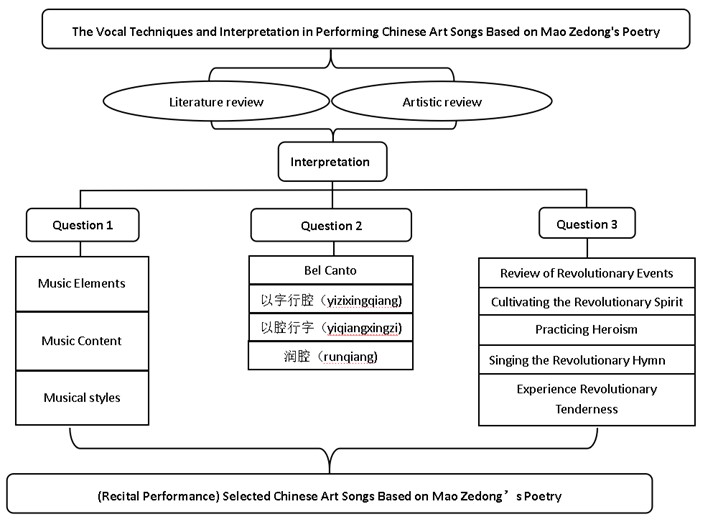Vocal Techniques and Interpretation in Performing Chinese Art Songs Based on Mao Zedong's Poetry
Abstract
Mao Zedong’s poetry significantly influenced Chinese vocal music in the 20th century and has been reflected in the creation of many Chinese Art songs. These songs are highly regarded in the Chinese music industry and are considered great works of Chinese literature and art. However, there is a lack of discussions on Chinese Art Songs based on Mao Zedong’s poetry. This research aims to interpret and perform the musical styles of selected Chinese art songs based on Mao Zedong's poetry. This study encompasses three research objectives. The first is to identify the characteristics inherent in Chinese Art Songs based on Mao Zedong’s poetry. The second objective involves the interpretation of the technical aspects of Mao Zedong’s poetry in the context of Chinese art songs. Lastly, the third objective aims to perform selected Chinese art songs based on Mao Zedong’s poetry in the form of recitals. This study will be conducted through the practice-based research framework, wherein textual and non-textual documentation will be utilized to report on the practice. By exploring the integration of Mao Zedong’s poetry into art songs, this study provides a distinct approach to interpreting and conveying his poetry's emotions, themes, and ideas.
References
[2] Aberbach, D. (2003). The poetry of nationalism. Nations and Nationalism, 9(2), 255–275. https://doi.org/10.1111/1469-8219.00085
[3] Achieng’Akuno, E. (2019). Postlude: Singing Africa. In Music education in Africa (pp. 327–332). Routledge. https://doi.org/10.4324/9780429201592
[4] Agawu, V. K. (2009). Music as discourse: Semiotic adventures in romantic music. Oxford University Press. https://doi.org/10.1093/acprof:oso/9780195370249.001.0001
[5] Altorjay, T. (2014). Experience of flow during singing. Practice and Theory in Systems of Education, 9(2), 143–151.
[6] Applegate, C., & Potter, P. (Eds.). (2002). Music and German national identity. University of Chicago Press.
[7] Attridge, D. (2019). The experience of poetry: From Homer's listeners to Shakespeare's readers. Oxford University Press. https://doi.org/10.1093/oso/9780198833154.001.0001
[8] Baade, C. L. (2012). Victory through harmony: The BBC and popular music in World War II. OUP USA. https://doi.org/10.1093/acprof:oso/9780195372014.001.0001
[9] Bernstein, I. (1993). Promises kept: John F. Kennedy's new frontier. Oxford University Press.
[10] Borgdorff, H. (2012). The conflict of the faculties: Perspectives on artistic research and academia. Leiden University Press. https://doi.org/10.26530/OAPEN_595042
[11] Burnard, P. (2012). Musical creativities in practice. Oxford University Press. https://doi.org/10.1093/acprof:oso/9780199583942.001.0001
[12] Candy, L., & Edmonds, E. (2018). Practice-based research in the creative arts: Foundations and futures from the front line. Leonardo, 51(1), 63–69. https://doi.org/10.1162/LEON_a_01471
[13] Casper, J. K., & Leonard, R. (2006). Understanding voice problems: A physiological perspective for diagnosis and treatment. Lippincott Williams & Wilkins.
[14] Chen, S. X. (2015). The development of Chinese folk vocal music from the singing of Chinese art songs based on Mao Zedong's poetry works. Northern Music, 35(21), 14.
[15] Chen, X. (2016). The origin and development of Chinese art songs. Walk Together, 11, 441–425.
[16] Chen, Y. Q., & Yang, B. H. (2024). Interpretation of the aesthetic characteristics of Huang Zi's art songs. Journal of North China University (Social Sciences Edition), 40(06), 139–145.
[17] Cheng, R. (2018). On the diversity of Chinese art songs based on Mao Zedong's poetry composition: Taking "Qing Ping Yue Liu Pan Shan" composed by He Luting, Jie Fu, and Tian Feng as an example. Northern Music, 38(21), 6–7.
[18] Cho, W. (2011). Verdi and his dramatic basses: A study of Verdi's evolution for bass voice (Doctoral dissertation, The University of Memphis).
[19] Cook, N. (2014). Beyond the score: Music as performance. Oxford University Press. https://doi.org/10.1093/acprof:oso/9780199357406.001.0001
[20] Cook, N., & Everist, M. (Eds.). (1999). Rethinking music. OUP Oxford. https://doi.org/10.1093/oso/9780198790037.001.0001
[21] Cui, C. (2021). Western and Chinese musical traditions in 20th century China: Developing an American pedagogy for "Chinese classical poetry art song." (Doctoral dissertation, University of Georgia).
[22] Dabney, J. P. (1927). The relation between music and poetry. The Musical Quarterly, 13(3), 377–383. https://doi.org/10.1093/mq/XIII.3.377
[23] Davidson, J. W. (2009). Movement and collaboration in musical performance. In The Oxford handbook of music psychology (pp. 364–376).
[24] Djahwasi, H. R., & Zaharul L. Saidon. (2020). Artistic research: Artistic as research vs. artistic as method. International Journal of Academic Research in Business and Social Sciences, 10(11), 292–309. https://doi.org/10.6007/IJARBSS/v10-i11/8091
[25] Dong, J., & Hu, X. L. (Eds.). (2017). The anthology of Chinese drama theory in the 20th century. Anhui Education Press.
[26] Dowd, A., Smith, J., & Wolfe, J. (1998). Learning to pronounce vowel sounds in a foreign language using acoustic measurements of the vocal tract as feedback in real time. Language and Speech, 41(1), 1–20. https://doi.org/10.1177/002383099804100101
[27] Edmunds, N. (2004). Soviet music and society under Lenin and Stalin. New York. https://doi.org/10.4324/9780203496268
[28] Elliott, M. (2006). Singing in style: A guide to vocal performance practices. Yale University Press.
[29] Evans, R. C. (2014). Perspectives on World War I poetry. A&C Black.
[30] Fairclough, P. (2016). Classics for the masses: Shaping Soviet musical identity under Lenin and Stalin. Yale University Press. https://doi.org/10.12987/yale/9780300217193.001.0001
[31] Fan, Z. Q. (2018). Exploring the heroism and romantic sentiment in the interpretation of Mao Zedong's poetry songs (Master's thesis, Hunan Normal University).
[32] Fang, S. (2014). Meaningful, interesting, and unexpected: Listening to Xu Peidong’s new song "Qinyuanchun: Changsha" based on Mao Zedong’s poetry. People’s Music, (02), 30–31.


This work is licensed under a Creative Commons Attribution 4.0 International License.
Copyright for this article is retained by the author(s), with first publication rights granted to the journal.
This is an open-access article distributed under the terms and conditions of the Creative Commons Attribution license (http://creativecommons.org/licenses/by/4.0/).









1.png)














